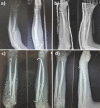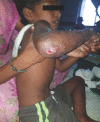Pediatric Forearm Fractures: Investigating the Functional Outcomes of Titanium Elastic Nailing for Unstable Both-Bone Fractures
- PMID: 38784879
- PMCID: PMC11111224
- DOI: 10.13107/jocr.2024.v14.i05.4474
Pediatric Forearm Fractures: Investigating the Functional Outcomes of Titanium Elastic Nailing for Unstable Both-Bone Fractures
Abstract
Introduction: Diaphyseal forearm fractures pose a common challenge in children and adolescents, impacting forearm function due to rotational deformities and angulation. The landscape of pediatric forearm fracture treatment has seen limited progression, with increased surgical intervention adoption driven by factors such as functional implications, technological advancements, societal expectations, and legal concerns.
Materials and methods: This study enrolled consecutive children aged 5-16 years with forearm fractures presenting between August 2018 and January 2020, requiring surgical intervention. The study assessed functional outcomes and complications in children treated with titanium elastic nailing.
Results: Sixteen patients underwent surgery for both-bone forearm fractures. Elastic nailing was the primary intervention, with 75% undergoing closed nailing. Patients' ages ranged from 5 to 15 years, with 87.5% being male. The study evaluated fracture characteristics, surgical procedures, post-operative care, and complications.
Conclusion: The study demonstrates promising outcomes for flexible intramedullary nailing in pediatric forearm fractures. Despite the observed complications, the majority of cases achieved excellent results in fracture union and patient recovery, supporting the efficacy of this technique. Larger cohorts are needed for a comprehensive understanding of its applicability and outcomes in pediatric forearm fracture management.
Keywords: Pediatric forearm fractures; flexible intramedullary nailing; functional outcomes; surgical intervention; titanium elastic nailing.
Copyright: © Indian Orthopaedic Research Group.
Conflict of interest statement
Conflict of Interest: Nil
Figures



Similar articles
-
A new mini-invasive technique in treating pediatric diaphyseal forearm fractures by bioabsorbable elastic stable intramedullary nailing: a preliminary technical report.Scand J Surg. 2013;102(4):258-64. doi: 10.1177/1457496913490459. Epub 2013 Sep 20. Scand J Surg. 2013. PMID: 24056134
-
Comparison of Titanium versus Resorbable Intramedullary Nailing in Pediatric Forearm Fractures.Children (Basel). 2024 Aug 5;11(8):942. doi: 10.3390/children11080942. Children (Basel). 2024. PMID: 39201877 Free PMC article.
-
Intramedullary Flexible Nailing for Diaphyseal Fractures of Forearm Bones in Children.Rev Bras Ortop (Sao Paulo). 2019 Sep;54(5):503-508. doi: 10.1055/s-0039-1693742. Epub 2019 Aug 27. Rev Bras Ortop (Sao Paulo). 2019. PMID: 31736519 Free PMC article.
-
Flexible intramedullary nailing in the treatment of forearm fractures in children and adolescents, a systematic review.J Orthop. 2020 Jan 14;20:125-130. doi: 10.1016/j.jor.2020.01.002. eCollection 2020 Jul-Aug. J Orthop. 2020. PMID: 32025135 Free PMC article. Review.
-
Use and abuse of flexible intramedullary nailing in children and adolescents.J Pediatr Orthop. 2006 Nov-Dec;26(6):827-34. doi: 10.1097/01.bpo.0000235397.64783.d6. J Pediatr Orthop. 2006. PMID: 17065959 Review.
References
-
- Waters PM, Skaggs DL, Flynn JM. Rockwood and Wilkins Fractures in Children. Philadelphia, PA: Lippincott Williams &Wilkins; 2019.
-
- Noonan KJ, Price CT. Forearm and distal radius fractures in children. J Am Acad Orthop Surg. 1998;6:146–56. - PubMed
LinkOut - more resources
Full Text Sources
